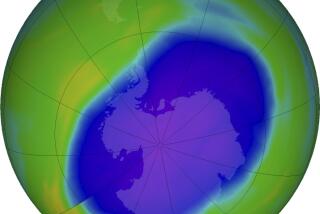Science / Medicine : Mysterious Loss of Ozone Found Outside ‘Hole’
- Share via
Part of the Earth’s protective ozone layer is being mysteriously destroyed outside the well-known Antarctic “ozone hole,” indicating current understanding of ozone destruction may be incomplete, a study suggests.
Scientists also found evidence that ozone is destroyed before the hole forms every year, said researcher M. H. Proffitt.
Nobody knows why this ozone is disappearing, he said. So the new study means scientists still must work to get a complete understanding of the important problem of what destroys ozone in the atmosphere, he said Wednesday.
Other scientists urged caution in interpreting the research but said it is potentially significant.
Ozone, a form of oxygen, is a pollutant at ground level but beneficial high in the atmosphere, where it shields out ultraviolet rays that can promote skin cancer.
Protection of the globe’s ozone shield has become a focus of international concern, focusing on the use of compounds called chlorofluorocarbons. Chlorine from those compounds is implicated in causing the ozone hole, an area of annual, temporary ozone destruction.
The latest study appeared in last week’s issue of the British journal Nature. Its authors include Proffitt, of the Cooperative Institute for Research in Environmental Sciences, a joint venture of the National Oceanic and Atmospheric Administration and the University of Colorado. The other co-authors are with NOAA.
The scientists found evidence of ozone destruction at altitudes of about 11 to 12 miles by analyzing readings taken during airplane flights during 1987.
In an unusual approach to measuring ozone losses, the researchers first determined an apparently normal minimum ratio of ozone levels to amounts of nitrogen compounds. When a given sample of air showed a lower ratio, it was considered to have lost some ozone.
Using this method, the researchers found evidence of ozone loss averaging at least 15% to 30% outside the ozone hole, the limits of which roughly correspond to the outline of Antarctica.
The new-found area of depletion extended about 300 miles outside the boundary of the ozone hole and perhaps twice that far, Proffitt said in a telephone interview.
In addition, losses inside and outside the area covered by the ozone hole were observed in mid-August, before the formation of the hole in September.
The researchers concluded that losses outside the ozone hole were caused by some sort of chemical reaction.
Robert de Zafra of the State University of New York at Stony Brook, who has studied the chemistry of the ozone hole, cautioned that the researchers used only an indirect means of detecting ozone loss.
Still, if their analysis near the ozone hole “holds up and is verified by other, more direct measurements, then this is a fairly major and significant finding that will send people scurrying to try to determine the cause of it,” he said.





